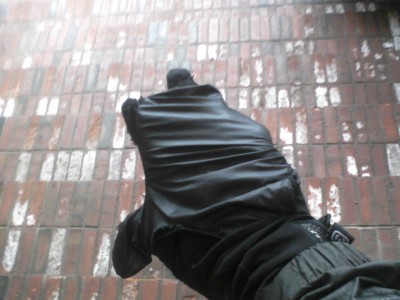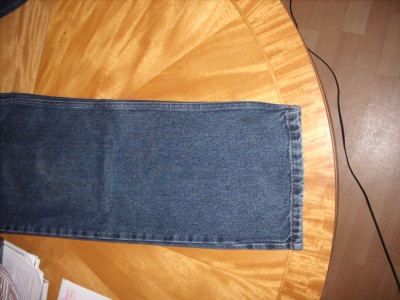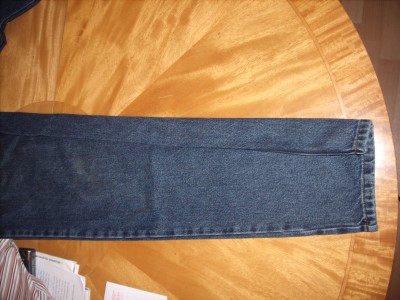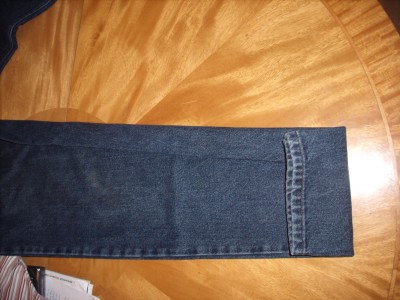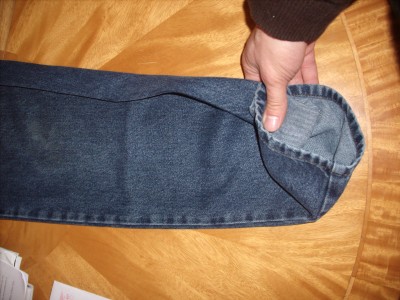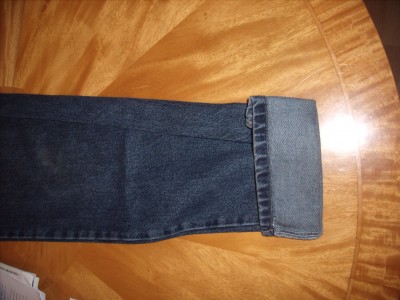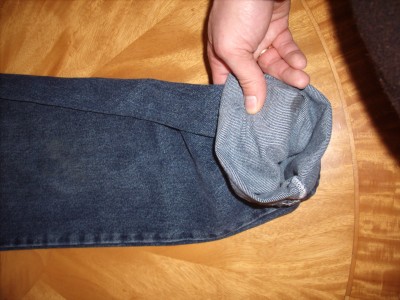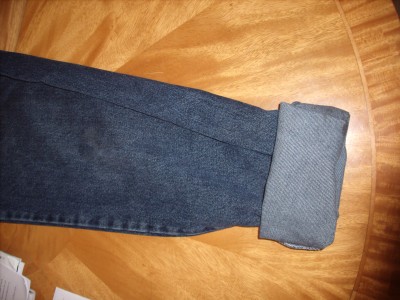A Hitch in the Plan
March 23rd, 2012
So my plan after leaving my office job was to be able to maintain my “weather and clothing” posts. The flaw in that logic is twofold: I’m riding for transportation less, and I’m able to wear casual clothing while doing it. The concept that started this blog (two months ago, so long ago!) was to help novice commuters with less generic advice than is normally offered. So, I will continue to offer advice based on the weather conditions, but chances are I won’t be exercising that exact advice.
Weather
The last few days have seen some downright summertime weather, with morning temperatures in the 60s and highs up to 80. As I’ve mentioned before, in those situations, I recommend one of two approaches. If you have a gym membership or don’t mind braving the filth of a Planet Fitness locker room, ride in whatever you feel like and shower or change when you arrive at your destination. I did this when I first started working downtown, and while I tried it in both summer (hot!) and winter (dirty), I found that it made riding to work downright cumbersome.
My preferred strategy is to ride more slowly, and maximize airflow over the body to keep the skin cool. Since I used to work in a “business casual” office, that meant riding in a T-shirt and then putting my collared shirt on when I got to my destination. Wearing lighter shoes, such as sneakers or loafers without socks, made a huge difference versus the waterproof walking shoes I wore all winter. I just wore my regular office pants, rolled up to avoid grease. As always, I recommend using a bag that attaches to the bike as this is both cooler for you and also neater for your clothes.
I always found it difficult to avoid sweating when the temperature exceeded 70 degrees on my ride in. For that, it’s all about mitigation, namely, ride slower.
Five Items for New Transportation Cyclists; Hot and Dry
March 21st, 2012
I’m not usually a list person, or if I am, I prefer prose. Today, I’ll make an exception and try to summarize the top things someone new to transportation biking should be aware of.
- Learn how to ride safely on the road. My mantra is be visible.
- Get a bike that fits, and keep it in working condition. There are lots of factors for a good bike fit, but for commuting and getting around, generally you want a bike that keeps you sitting more upright so you can see and be seen (how fashion-conscious!) on the road. If you hear squeaks of agony (from the bike) or the brakes aren’t snappy, get that taken care of by a shop.
- Figure out routes that work for you. You’re going to be taking different roads than if you were walking or driving. While Google Maps has biking directions, I find them to be generally pretty bad because of their slavish devotion to marked bike routes (a nearly meaningless distinction, usually). Find what works for you be trial and error and talk to other bikers.
- Decide how you’re going to carry things. Don’t put things on your back if you want to arrive presentable. Don’t put things on your handlebars if you want to survive. Instead, get a rack with panniers or a basket.
- Figure out dress that works for you. I know this is particularly an issue for ladies, but you’ll have to prepare by wearing much cooler outfits (when you’re rocking and rolling along) and much warmer outfits (when it’s windy or cold and you’re not generating as much heat).
That about sums it up. Now I can stop blogging, forever. 🙂
In other news, I posted my instructions for the Large Panniers for CETMA rack. Whether you make these bags or a different roll-top type pannier, I hope these instructions are helpful.
Weather (from 3/20)
Temperature: 81
Road condition: Dry
Clothing: Long sleeve T-shirt, jeans, loafers (w/o socks)
Comfort: Awful. As you might imagine, the best way to deal with this temperature is light fabrics and short sleeves. I was in a black T-shirt and jeans. Don’t do that.
If I were commuting to an office at a morning temperature above 70, I would neatly store my button-up shirt, and untuck the undershirt, and take it slowly. Or, if you’re going far enough, plan on changing clothes.
Warm and Dry
March 20th, 2012
Today is the first day of spring! (I’ll put a “winter” tag on this post because it pertains to yesterday, though). Fair weather bikers, rejoice!
Weather
Yesterday was truly spring-like: it felt like 70 during the day, but by 7 pm it was already quite cool. That meant that you really needed to layer or expect to be very uncomfortable at some point.
Temperature: 70 / 50
Road condition: Dry
Clothing: Long sleeve T-shirt, Jeans, loafers (w/o socks)
Comfort: I was very much on the warm side during the day, and borderline on the cold side by the evening. I’d say, I need to take my own advice.
EVO Drone Gloves; Warm and Dry
March 8th, 2012
Although today is a springlike day, I thought I would reflect on the EVO Drone gloves I’ve been wearing. The exact product name escapes me (and google is no use), so I’ll have to fill that in later. They’re made of thin Nylon fabric, which is pretty good about not sucking up rain. They have the “hunter” thumbs and index fingers, which are good for checking your phone without taking the gloves off. What makes them truly useful is the attached outer mitten – I’ve found this allows you to stay warm and extra 10-15 degrees of outside temperature by defeating the wind and holding in heat. It’s an air impermeable synthetic that is sewn into the wrist of the glove and folds into the top when you’re not using them. (If you’re neat, they don’t look bulbous, either!) Although the seam on these covers has a bad habit of ripping under normal use, this hasn’t compromised the performance of the glove. You can see in the attached picture how I can get a few fingers through that cover after a few months of riding. They’re not too expensive (around $30?), and Hub Bicycle Company in Cambridge carries them. Of course, now that it’s just about spring, you’ll have no occasion to use them…
I suppose now that I’m overtly recommending products, I should announce that I’m moving from my current, non-bike related job to start working at Hub Bicycle Company. I’ve been going there as a customer since a few months after the shop opened two years ago, and as I became disenchanted work in the soul-stealing financial industry, I also discovered that I’m cuckoo for bikes. I can safely say – as a customer – that it’s an awesome bike shop, but don’t believe me, believe Yelp. I’m going to be working there full time starting later this month, which means I’ll be reporting more second hand on bike commuting (on customer attire, as the shop is walking distance), but there will still be plenty of errand running and general transportation riding.
Weather
Temperature: 57 degrees
Road condition: Dry
Clothing: Light spring jacket, timberland shoes, light Pearl Izumi gloves, messenger bag
Comfort: I was definitely too warm. Every time the weather changes I relearn the lesson: slow down, wear less. Today would have been OK without a jacket.
It was windy today, and should be more so later, according to the forecast. There were tons of bikers out, and I expect many, many more next week.
Dooring; Cool and Wet
February 17th, 2012
Yesterday, I went to the Boston Cyclists Union meetup around the Climate Ride. It was lovely to meet or reacquaint myself with all those folks. In fact, you can sponsor one of the three (four?) riders from the BCU and the organization will get that donation! (or an extra donation? Anyone more knowledgeable care to clarify?)
One of the people I met says he has been doored five times; four times in the last year. He quoted the old biking proverb (in various forms), that there are two kinds of bikers: those who have been doored, and those who will be. Aside the obvious response, “you need to ride farther from the cars,” I offer up lifelong cyclists who have never been in any kind of crash (I know a few). It truly is not necessary for drivers or bikers who are operating defensively to get into crashes. Granted, it is difficult to practice that kind of safe riding in a very hostile environment, but I counter that Boston, even with its many bike-lane parkers, lack of driver signalling and heavy traffic, is not such an place.
Weather
Temperature: 44
Road condition: Wet (but not raining)
Clothing: Heavy winter coat, timberland shoes, no rain pants
Comfort: Warm! I zipped into work today, and definitely ended up too warm despite opening my coat. I didn’t realize how high the temperature was when I started riding, or I would have gone with a lighter coat.
I’ll also note that last night I rode home in the light rain. The fenders and waterproof clothing (no rain pants, though) were sufficient for the 15 minute trip. The thighs on my pants were definitely wet, but it would probably have been rather unpleasant were I not going home and changing.
Cool and Clear; Eyewear
February 2nd, 2012
This morning was a carbon copy of yesterday morning – 38 degrees, clear and dry. Yesterday evening, however, was downright spring-like. It was almost 60 degrees when I rode home, and I have the sweatiness to prove it. Once the temperature gets that high, you have to really start thinking about cooling: if I had thought harder about it, I would have rolled up my sleeves and untucked my shirt, and slowed down.The last part is clutch: if you want to get someplace presentable, add a couple minutes and ride slower. I would have also liked lighter shoes, but that was unreasonable to ask for.
Clothing: Heavy winter coat, messenger bag, waterproof shoes over my normal dress shirt & undershirt; cotton dress pants.
Yesterday’s post spontaneously generated a (small) discussion on eye wear. I know this usually gets short shrift on “what to wear” guides, but the consensus from our three data points were:
1. Eyeglasses are good in the winter: they keep your eyes warmer (especially in the bitter cold and wind) and they keep them protected from debris.
2. Fogging is inevitable. In my experience with ski goggles and eyeglasses, the important thing is to keep your face away from the glasses (good luck!) – facewear that directs warm air from your nose and mouth upward will cause immediate fogging. One other person contributed that he keeps the glasses down at the tip of his nose to get the same effect. Once fogged, I take the glasses off and wave them around: the moisture evaporates in a few seconds.
Many kinds of wipes that prevent fogging exists, and wikipedia tells me some home solutions exist for this purpose:
Home recipes
One method to prevent fogging is to apply a thin film of detergent, but this method is criticized because detergents are designed to be water soluble and they cause smearing.[5] Divers often use saliva,[6] which is a commonly known and effective anti-fogging agent.[7] Other home recipes exist, including the application of white vinegar with hot water,[8] or a mixture containing sudsy ammonia, alcohol and liquid dishwasher detergent .[9]
Some other tips I found on the web, which suggest saliva or shaving cream, vinegar, and shampoo. I’ll try to go out and try one of these (probably the shaving cream), and report back at a later date. (Perhaps when it’s actually cold enough to cause fogging!).
Warmer and dry; Chains
February 1st, 2012
Today is supposed to be very warm, so I scaled down from the winter coat to a sweater plus rain jacket. I won’t repeat myself on how the fixed gear causes me to run warmer than usual, but today was another case in point of overheating. The temperature wasn’t actually so high – 37 degrees – but it sure felt warm.
Clothing: Light sweater, waterproof windbreaker, waterproof shoes, messenger bag. Light cotton (?) biking gloves.
If you canvas ten bicycle-inclined people and ask them about maintenance, nine of them will talk about the chain (and the other one will be clever). It bears repeating that if you do any of the following things, you need to clean and oil your chain at least once a month, and probably more often.
1. Ride your bike more than twice a week
2. Ride in rain or snow, even once
3. Store your bike outside
4. Ride off road
As regular transportation cyclists, we all see, and then hear, those bikers who are crawling along, straining their muscles to go five miles an hour, the bike shrieking as though in pain, and the chain recently dredged from the hold of the Titanic. We love to blog about them. I really wanted to make pamphlets to hand to bikers inching up the Longfellow Bridge in spring explaining how to do it (if anyone’s interested, I have other informational ideas, although the whole medium of unsolicited advice is a little obnoxious). I’ll resist the desire to say more, except, clean your chain!
Cool and Dry; Tires
January 31st, 2012
Today was another uneventful winter commute. Dry ground (save the open fire hydrant on Cambridge Street in Beacon Hill), high 30s, nothing special to report. I took the fixed gear today because the forecast was nice. The lack of fenders (see, they’re useful even in fair weather!) made me nervous for my clothing through the aforementioned water on the street.
Clothing: Heavy winter coat, wool gloves, waterproof shoes. No rain pants; messenger bag.
True to form, the fixed gear made me ride harder than usual (I love the way it pushes you up hills!) and the messenger bag constricted me a little. I managed to break a sweat.
I haven’t pumped my tires the entire month. This is a luxury you have in the winter: air escapes much more slowly when the temperature is below 50 degrees. (I’m sure it has something to do with the rubber becoming more porous, but that’s a tire engineer’s concern.) In the summer, if you aren’t pumping the tires once per week, then you feel as though you’re riding on a wet sock.
The reasons to stay on top of tire pressure are for performance (avoiding “wet sock” syndrome) and for “pinch flat” prevention. I also think that tires which are generally puncture resistant (from road debris) also perform better at higher pressure as they can scatter the debris as you ride instead of flopping down on its sharp edges.
Clear and Cool; Roll Up Your Pants, Better
January 25th, 2012
The ride in today was just lovely. It was cool (38 degrees) but not cold; the pavement was dry; the traffic was light (har har). I rode the fixed gear today and boy was it fun. I forget how I have to resist the temptation to tear it up on that bike – I get into work all overheated.
Clothing: Heavy winter coat, gloves (although I took them off halfway through the ride), waterproof shoes. NO rain pants today (a winter treat!).
Every so often I’ll see someone riding along with an absolutely atrociously rolled up pant leg. The pants are crumpled the whole length, the bottom is balled into the back of their knee, and their bare leg is exposed to the cold. It gets the job done, but this method is uncomfortable, unsightly, and results in very wrinkled clothing after the ride.
Rolling up your right pant leg is a necessity (unless you have a chain guard, or you’re wearing shorts, duh), as it will keep the bike from at the least rubbing grease on your pant leg, and and at the worst from ripping a hole in the pants or causing you to lose control. (All these things have happened to me – see below.) If your bike is really dirty, it may behoove you to roll up the left one too (a lot of the cuffs on my left pant legs have black streaks from rubbing grit off the frame).
The proper way to roll up your pants (and shirt sleeves!) came to me by way of the military, which, you may know is a stickler for neatness. The key is not to just push the offending fabric out of the way, but rather to fold the excess into a flat, neat cuff. This is basically the same technique you would use if you were tight rolling jeans, and it’s easy with a little practice (best done with the clothes off you to remove some variables). I’ll explain how to do it standing over your clothes and you can extend it to when you’re wearing it.
1. Lay the pants flat on a surface, face up, with the seams on the side and the fabric smoothed out.
2. Fold the inseam over an inch. The amount you fold over can vary depending on the amount of taper in your pant leg.
3. Fold the bottom of the leg up 1-3 inches (depending on your preference; it is easier to do when you use more fabric).
4. With one hand (let’s say, your right) pinching the back of the pant leg and inside the fabric from step 3, gently form a cuff with your left hand with the remaining fabric by turning it inside out and smoothing around your right hand.
5. Repeat steps 3 and 4 one or two more times. Two rolls will give you a more secure roll.
If your pants are pretty snugly fitting, you don’t need to do step 2: the cuff will remain neat without gathering the extra fabric. When done properly, you can create a very neat roll which will not crease your clothing and will also keep your pants away from the chain.
* The worst chain chomping I’ve had was in Times Square in August 2010. It wasn’t the chain’s fault, per se, but it had similar effect. I was making a right turn on about 47th Street on my fixed gear, when an errant shoe lace on my left foot got wrapped around the crank. With every revolution (as I frantically backpedaled and slammed on the brake), my foot was bound tighter and tighter. When I came to a stop, my weight listed… left and I slowly tipped over. This being New York, nobody batted an eyelash at some biker falling over for no reason in the middle of the street. I picked up the bike and literally hopped to the curb to unravel my shoelace.
** The worst clothing-chain chomping I’ve seen was when my fiancee and I were riding on Cambridge Street near Harvard Square, totally flying along when her bike (also a fixed gear) comes to a screeching halt and she falls to the side. Her pant leg was totally caught inside the chain, and the tire was rubbed flat through the tread.
Spring Is Here (?); Bags
January 24th, 2012
I should announce in advance any time I have to wear a suit to work: it is highly correlated with weird weather. Often it’s a heavy storm or cold snap, but today it appears to be freakishly warm (46 degrees this morning).
Technically, wearing a suit is no different from wearing other clothing. However, for me it adds a few complications: the jacket (what to do with it, as it’s long and sticks out of coats), cleanliness (you don’t want to get grit or slush on that bad boy), and the shoes (I usually leave my shoes at my desk). If this were most any other season, I might consider just wearing everything. Since this is the Dirty Season (winter to the lay person), I wear my rain pants, any coat, my normal bike-to-work shoes, and pack the jacket and shoes in panniers.
Clothing: Rain jacket, rain pants, waterproof shoes. No gloves.
I got a little warm riding in despite the light clothing. The key is airflow. I already had the tie knotted, and the shirt tucked in; the rain clothes add extra constriction. However, the biggest factor that kept me from getting actually sweaty was the bag. Any kind of bag on your body (whether two strap backpack or a messenger bag) will effectively increase the temperature by at least 10 degrees. The reason is airflow, for two reasons. The first is that there’s no air whatsoever under the straps: your body tries to remove heat, and so it sweats and nothing can escape. This ends up soaking your clothing in weird patches. Second, the straps obstruct any air from circulating between your skin and the openings in your clothing (around your neck, arms, and maybe lower back), which raises your overall temperature. If I want to arrive someplace presentable, I go for panniers.
Since I’m recommending them, I’ll go ahead and say that most any pannier will work. I have Axiom Typhoon LX panniers because that’s what the store had when I urgently needed a bigger bag the night before leaving on a touring trip. (It turns out the saying is true that you will fill whatever size bag you have, however.) They’re dry bag style, totally waterproof, and a giant sack. That’s not ideal because whatever you need is inevitably on the bottom of the sack, however the waterproof property and tough material makes these a good buy.
